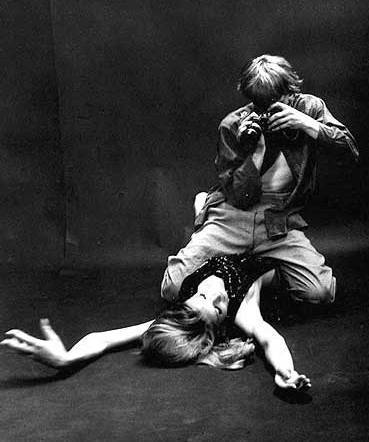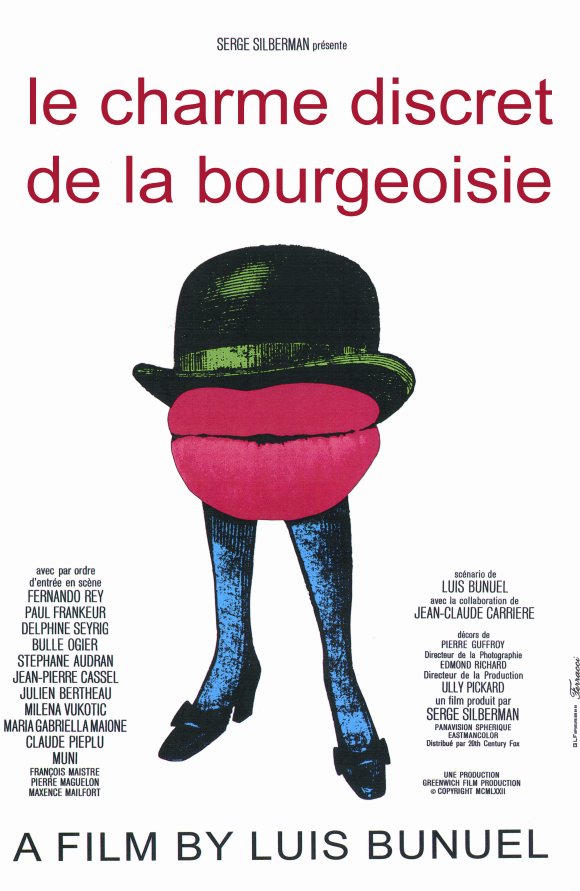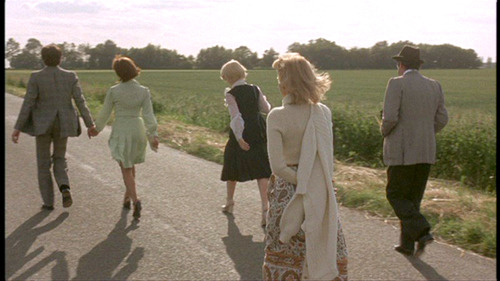Abhigyan-da, now a good friend of mine, requested me a couple of days back that I make a list of 10 Bengali films, both old and new, which are worth seeing. Well, obviously it has been a hard time making such a list. A lot of good works and some of my favourites have been left out (with much heart-ache, I must say! :P). I’ll violate two conditions though: I’ll list 15 films, instead of 10 and I’ll, for now, talk only about old films, i.e., the black-and-white-era. Also, these are among those which I’ve seen and so, this is absolutely my opinion. But, I have tried to be as unbiased as possible. I’ve also tried to bring as much diversity to my choices as is possible. No two films are thematically the same, as far as I can see. I’ll leave the often-seen-obvious-great-works-that-have-received-enough-recognition (like the ‘Apu Trilogy’, the Goopy-Bagha series, ‘Charulata’, ‘Nayak’, ‘Meghe Dhaka Taara’, ‘Galpo Holeo Shotti’, ‘Kabuliwala’, ‘Saptapadi’ and probably a few others):
1) Teen Kanya (director: Satyajit Ray, year: 1961) – A classic collection of three short films. All the basic elements of drama (humour, poetry, horror, romance, psychology, coming-of-age, relationships, time…) are so innately combined to give perhaps one of the world’s most memorable art forms.
2) Jana Aranya (director: Satyajit Ray, year: 1975) – A clever take. There have been many stories portraying the struggle of youths to find a job in Naxal or post/ pre-Naxal period, the earnest desire to make a proper living, ultimately finding a not-so-good offer with a happy-sad “atleast I’ve got something” feeling, the psychological pressure on a middle class family owing to the fear of losing security, and so on. But rarely has a film been made central characterising a man so utterly common! He is unromantic, uncharismatic, uncomplicated, un-plottable, un-philosophical. But, he is uniquely conscientious. A great find, Pradeep Mukherjee, is one of the most under-under-rated actors in the world film industry.
3) Jalsaghar (director: Satyajit Ray, year:1958) – A must-see to grow a universal view of the world. Even the autocrat or the aristocrat might have a softer, weaker mould hidden beneath several layers. The power, the aura, the luxurious ways of amusement (from smoking the pricey tobacco to arranging the royal festivity) – all are linked with an odd sense of childish possessiveness and of course, pride, a super sensitive pride. A hint of fall brings devastative remorse (shade comparable with that depicted in Billy Wilder’s ‘The Sunset Boulevard’). Mind-boggling work with psychology!
4) Kshaniker Atithi (director: Tapan Sinha, year: 1959) – A tale so sensitive can’t be said in a simpler way. Only someone like Tapan Sinha could produce such magic perhaps. Great cast selection! Nirmal Kumar says most with his wordful eyes. It leaves a ‘songful lull’ long after it is over, if there can be any such thing.
It makes the viewer re-discover the many bits of precious shattered glass that cover his path, some of which can’t be retrieved again, some of which can still be collected...
5) Ajantrik (director: Ritwik Ghatak, year: 1958) – A very important subject, but has been rarely worked upon: man’s relationship with machines. I think, I don’t need to say more to the people here reading this on Facebook or on the blog! :P But, yes, this film is about how much a machine can become the part of our very selves. I think most people of the 20th – 21st century will connect to this film a lot. Enjoy!
6) Ahwan (director: Ardhendu Mukherjee , year: 1961) – A tale of simplicity, of the wish of “giving” amidst and despite utter poverty, of the mindlessness of the thousand divisions in the society and of the inexplicability of those rare relationships that know no beginning nor any end. Watch this film for the very old lady, wrinkled, toothless and bent with age, who has abundant affection stored in her being, but very precious few to shower it on.
7) Jhinder Bondi (director: Tapan Sinha, year: 1961) – A royal film, both in terms of subject and treatment. Can be a million-budget film if made today, but still the effect of the original, which had a budget that will embarrass modern producers, can’t be reproduced. The cast is superbly selected, once again! And, all the actors, away from their comfort zones (except Uttam Kumar perhaps, who doesn’t have to work much hard to be in the skin of the characters he plays here and as usual he is easily cool), have done their bit perfectly. The backdrop of the film, i.e., the Rajasthani royals, is very rare in Bangla cinema but is done with all the required élan and elegance. A sumptuous bit of art. Just lap it up!
8) Thaana Theke Aashchhi (director: Hiren Nag, year: 1965) – Rarely there has been such a neat work done on a highly complex mystery plot. Behind a man’s irreversible misery, that’s so huge to bring him to the brink of taking his own life, never is any one man or any one factor responsible. The entire society is. In fact, we might unexpectedly discover each of us responsible for the utter distress of that person (yes, quite in the Hitchcock-ian style). The unveiling of each such encounter with our victim might strike us – those with a wee bit of conscience, of course – with a wave of shame and guilt. And, we actually never know when we might come face-to-face with those cruelly honest and insightful eyes behind the black rimmed spectacles someday, which will reveal our “sins” to us! Watch this film to know why the fans of Uttam Kumar have turned the same.
9) Marutirtho Hinglaj (director: Bikash Roy, year: 1959) – One of the bravest and most difficult projects in Indian cinema. The story of a group of poor pilgrims who undertake a very difficult terrain in the wish to reach the “blessed spot” some place far away that they believe will get them salvation. Some very ordinary people like us are put to a series of indomitable tests. We see how some overcome them, while some fail. The huge amount of heart and dedication that is involved in this semi-epic is perceptible and is almost contagious. Watch this one just for the experience!
10) Bikele Bhorer Phool (director: Pijush Bose, year: 1974) – A remarkable film that brings out the eternal contrast between the young and the free on one side, while the mature and the limited/ bounded on the other side. While the former is fearless, the latter can’t afford to ‘dare to bare’. Due to years of struggle (and often by regular practice) against the odds, many layers of skin have covered their (the ones in the latter group) natural selves. They have learnt what the world can put up with and what it cannot. This “learning” is called maturity. Watch this again to understand The Uttam Kumar factor.
11) Neel Akasher Niche (director: Mrinal Sen, year: 1959) – A very affectionate story, drafted with a sadness strange to Bangla culture. A promising debut of course, for it made the permanent space for The Mrinal Sen, who later went on to develop a style, very different from his start, distinct to him. A very sensitive take on the refugees, on the ‘pain of compromising’ with the arrangement of living away from the homeland you love so much and how we suddenly find the shadow of our lost loved ones in someone practically “alien”, how we find a cross-road on a “foreign” land very familiar or how an unknown river reminds us of one back at home. After all, poverty, discrimination and war bring the same kind of distress everywhere. A very poignant tale!
12) Kaancher Swargo (director: Yatrik (Tarun Majumdar, Sachin Mukherji and Dilip Mukherji ), year: 1963) – A Bangla film noir. The story of a promising surgeon lost in the despairing pool of failure to gain a degree. But, can anything really stop him from applying the knowledge and the skill he possesses to save many hundreds of lives? How important law is when a man is dying? How important a stamp is when real work needs to be done immediately? Dilip Mukherji, an actor seldom appreciated, does most through his silent yet dignified grimness. A theme that surely demands a lot of importance even in contemporary times.
13) Dweep Jweley Jaai (director: Asit Sen, year: 1959) – One of the most touching and empathic tales in Bangla cinema. The best performance of Suchitra Sen undoubtedly. The director has revealed a very measured sense of drama in this film. Even melodrama is there, but very briefly and strongly. This is not only the story of an exceptionally kind nurse, or a dutiful human being for that matter, but of the general Indian lady.
14) Chupi Chupi Ashe (director: Premendra Mitra, year: 1960) – There have been many better works on crime and detection than this one. But, no other film like this one sent a chill down my spine. Very few films in Bangla have been made on serial killing. (In fact, right now I can’t remember another one except ‘Jighansha’.) Very few Bengali films have made the audience fear the murderer. In some way or the other, it has been the general tradition to justify the killer and draw a generous amount of sympathy from the viewer. There is a reason shown, of course, but very much like that in Hitchcock’s ‘The Shadow of a Doubt’: too skewed.
Crime lovers can try this!
15) Palatak (director: Tarun Majumdar, year: 1963) – It is an anecdote on the joy of losing oneself among all that is natural and true. And, I think, that one line will do. :)
Afterthought:
Most of these films are from the genre ‘drama’, are content-based works and were primarily made with “commerce” in mind. Music is one of the basic elements (both as songs and as background music) of these films, the medium that links the various nuances of the story in one unbroken garland. Again, many of the directors of the above films are scarcely named, scarcely known, scarcely remembered. But, the above list may roughly be an eye-opener to the question “why the golden age was golden age” that probes many bright young minds of today. Most of these films were hits in their times, signaling an average good taste residing in the then Bangali mass. Almost nil-resourced (‘resource’ includes money, access to capital, innovative mind in technique and style, eyes for detailed perfection, probably a sharper sense of art et al) and nil-equipped, in as many ways as possible, these film-makers made magic just because they had the mind-heart-and-eyes worth living! So, anyone earnestly wishing to know the “Bangali sentiment” may refer to the above list.
Happy seeing! :)

























